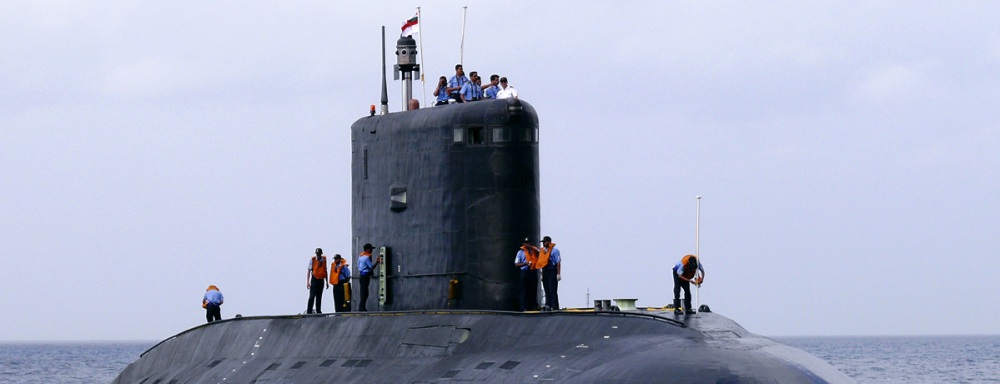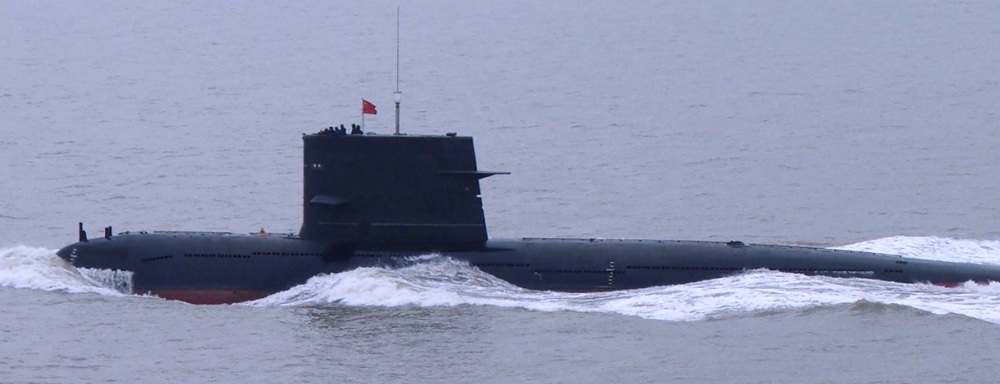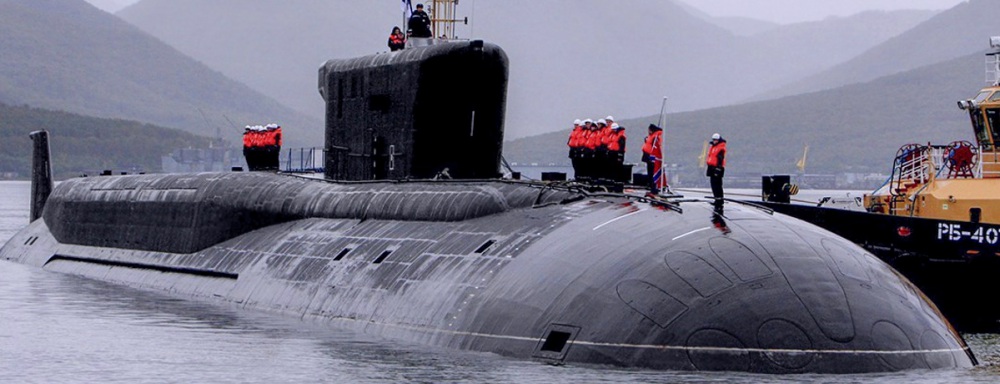
About the image
Capabilities at a Glance
The Indian Navy currently operates sixteen diesel powered submarines. India’s submarine fleet is based at two locations: Visakhapatnam on the east coast and Mumbai on the west coast.1
Total Submarines in Fleet: 16
-
Ballistic Missile Submarine (SSBNs): 1
-
Nuclear-Powered attack submarines (SSNs): 0
-
Diesel-electric attack submarines (SSKs): 15
-
Air-independent propulsion (AIP) enabled: 0
Submarines
History
While India discussed the potential of nuclear-powered submarines as early as the 1960s, it didn’t begin the development of its Advanced Technology Vessel (ATV) submarine program until 1983. (source) The ATV is a part of India’s sea-based nuclear deterrent, which is one of the three legs of India’s triad of airborne, naval, and land-based platforms as a minimum nuclear deterrent (MND). To gain further experience operating nuclear submarines, India negotiated a ten-year lease of a Russian Project 971 Schuka-B (NATO designation Akula II) class vessel.2
Modernization and Current Capabilities
In February 2015, the Indian government approved the indigenous construction of six nuclear-powered attack submarines at the Ship Building Center (SBC) in Visakhapatnam.3 On 29 June 2016, the Indian Navy signed a contract with Germany’s ThyssenKrupp Marine Systems (TKMS) to upgrade two of the four Shishumar-class diesel-electric attack submarines, including arming the boats with Boeing anti-ship missile systems.4 On 28 September 2018, India contracted TKMS again for an upgrade on the INS Shishumar (Type 209). The upgrade will be completed by 2021.5 In July 2018, Russian shipbuilder Zvezdochka and Indian shipbuilder Larsen and Toubro announced their partnership on an upgrade of the Kilo-class submarines.6 Currently, India is indigenously building six new Scorpène-class vessels at the state-owned Mazagon Dock Ltd. (MDL) in Mumbai in partnership with France’s Naval Group. The first of these submarines, the Kalvari, was commissioned in late 2017. The INS Khanderi (S22) was commissioned 28 September 2019.7 The INS Karanj (S23), the INS Vela (S24), and the INS Vagir (S25) were launched and passed sea trials in March of 2021.8 The remaining vessel, the INS Vagsheer is under construction.9
India’s nuclear-powered submarine program is under the management and operations (M&O) of the Defence Research and Development Organisation (DRDO), the Department of Atomic Energy (DAE), and the Indian Navy at Visakhapatnam.10 India took steps to operationalize its nuclear triad by commissioning its first ATV submarine, the INS Arihant, in August 2016.11 The INS Arihant carries 12 Sagarika (K-15) submarine launched ballistic missiles (SLBMs) with a range of around 700 km, as well as versions of the nuclear-capable Nirbhay cruise missiles.12 In January 2018, Indian media sources reported the propulsion system of the INS Arihant was flooded after a crewmember left a hatch improperly secured, leaving it inoperative for about ten months.13 However, in November 2018, it was announced that INS Arihant had undertaken its first deterrent patrol.14 The Indian government did not release information regarding the type of submarine-launched ballistic missiles (SLBM) the Arihant carried and whether they were mated with a nuclear warhead. Notably, the official Indian policy is to keep nuclear warheads de-mated from actual missiles.
In November 2017, India launched the second nuclear submarine of four planned Arihant-class nuclear submarines, the INS Arighat. The INS Arighat is expected to be commissioned by 2021.15 Additionally, the Indian Navy has begun construction on the remaining two Arihant-class submarines, the S-3 and S-4, at the shipbuilding center in Vadodara.16 The successors of the Arihant have long-range K-4 (3,500 km) SLBMs in lieu of the Arihant’s K-15 delivery systems.17 The second submarine in this class, the Arighat, has just completed sea trials and is expected to be commissioned in 2022.18 It has the same displacement as the Arihant.
In March 2019, India and Russia signed a deal for the lease of another Akula-class nuclear submarine to India for 10 years. The new vessel, called the Chakra-III, will be delivered to the Indian Navy by 2025.19 This leaves India without a nuclear-powered submarine for 5 years.
India recently constructed two submarine bases. The first is Karwar, located 500 kilometers south of Mumbai.20 The second is a secret naval base called the INS Varsha which is part of a larger project to increase India’s naval nuclear capabilities in response to China’s recent upgrades.21 This base is on the east coast near Kakinada and will have underground pens for the submarines.22
Ship Biographies
Sindhughosh-Class (Type 877EM)
India possesses eight working Sindhughosh-class diesel-electric attack submarines. These Kilo-class units act as the mainstay of India’s submarine fleet and are being progressively retrofitted to accommodate the Klub/3M-54E Alfa cruise missile system. These submarines are 72.6 meters long with a 9.9-meter-wide beam and can travel up to 18 knots when submerged. They can remain submerged for about 45 days without surfacing. Their weapons systems are capable of firing torpedoes and anti-ship missiles.23
Shishumar-Class (Type 209/1500)
India operates four Shishumar-class vessels designed by Howaldtswerke-Deutsche Werft (HDW) in Germany. While the first two vessels from the Shishumar-class were built at HDW, the third and fourth boats were constructed at the Mazagon Dock in Mumbai from packages supplied by HDW. These submarines are 65 meters long with an 8-meter-wide beam and can travel up to 22.5 knots when submerged. They can remain submerged for about 50 days without surfacing. Their weapons systems are capable of firing torpedoes. All four of the Shishumar-class vessels have undergone refits since they were commissioned.24
Chakra-Class
INS Chakra II is a Russian Akula-class nuclear-powered attack submarine. It is operated by the Indian Navy on a lease for 10 years. It was formally commissioned into service in India in April 2012.
Arihant-Class
India is expected to build four nuclear powered ballistic missile submarines (SSBNs) under its ATV Program. The first vessel in this class, INS Arihant, was commissioned in 2014. It is powered by an 83MW pressurized light-water reactor (PWR) fueled with enriched uranium. The Arihant-class submarines are 110 meters long with an 11-meter-wide beam and can travel up to 24 knots when submerged. They can remain submerged for about 50 days without surfacing. Their weapons systems are capable of firing torpedoes and submarine-launched ballistic missiles.
Kalvari-Class
India is expected to build six Kalvari-class diesel-electric attack submarines under its Project-75 program. The first vessel in this class was commissioned in 2017. The Kalvari class is based on the French Scorpène-class submarines. These submarines are 67.5 meters long with a 6.2-meter-wide beam and can travel up to 20 knots when submerged. They can remain submerged for about 50 days without surfacing. Their weapons systems are capable of firing torpedoes and anti-ship missiles.25
Import-Export Behavior
Imports
India has historically imported submarines from Germany, France, and Russia. In the last decade, it has decided to produce more vessels indigenously. For example, India originally planned to build four of its Scorpène-class submarines indigenously and import two. India has since announced that it wishes to produce all submarines natively.26 This is consistent with the 2014 Make in India initiative, which provides economic incentives when products are manufactured domestically.27
Exports
India is not an exporter of submarines. However, it decommissioned the INS Sindhuvir (S58) and sold it to the Myanmar Navy in March 2020, now called the UMS Minye Theinkhathu.28
Explore the Collection
Australia Submarine Capabilities
Brazil Submarine Capabilities
Chile Submarine Capabilities
China Submarine Capabilities
France Submarine Capabilities
Germany Submarine Capabilities
Greece Submarine Capabilities
Your are currently on
India Submarine Capabilities
Indonesia Submarine Capabilities
Iran Submarine Capabilities
Israel Submarine Capabilities
Italy Submarine Capabilities
Japan Submarine Capabilities
Malaysia Submarine Capabilities
Netherlands Submarine Capabilities
North Korea Submarine Capabilities
Pakistan Submarine Capabilities
Russia Submarine Capabilities
Singapore Submarine Capabilities
South Korea Submarine Capabilities
Sweden Submarine Capabilities
Taiwan Submarine Capabilities
United States Submarine Capabilities
Submarine Detection and Monitoring: Open-Source Tools and Technologies
Stay Informed
Sign up for our newsletter to get the latest on nuclear and biological threats.
More on
United States Submarine Capabilities
Overview of the United States' submarine capabilities and import-export behavior.

China Submarine Capabilities
A highlight of global trends in the sale and acquisition of diesel- and nuclear-powered submarines by country with capabilities, imports and exports. (CNS)

Russia Submarine Capabilities
Overview of Russia's submarine capabilities and import-export behavior.
Glossary
- SSBN
- Ship, Submersible, Ballistic, Nuclear: A hull classification for a submarine capable of launching a ballistic missile. The "N", or nuclear, refers to the ship's propulsion system. SSBN's are generally reserved for strategic vessels, as most submarine launched ballistic missiles carry nuclear payloads. A non-strategic vessel carries the designation SSN, or attack submarine.
- Diesel-electric submarine
- Diesel-electric submarine: A submarine with a diesel-electric transmission. Diesel-electric transmissions require access to oxygen for the diesel generator to charge the submarine’s batteries or drive the motor. This type of submarine is thus louder and must surface more frequently than a nuclear-powered submarine. A diesel-electric submarine can fire conventional cruise missiles against land targets, and in theory, can also carry nuclear-tipped cruise missiles. Diesel-electric submarines are significantly cheaper to build and purchase than nuclear-powered vessels, which makes them the vessel of choice for smaller navies.
- Air Independent Propulsion Technology (AIP)
- Air Independent Propulsion Technology (AIP): A propulsion system that uses liquid (or compressed) oxygen or hydrogen fuel cells, thereby allowing submarines to stay submerged for longer periods without the need for external sources of oxygen. This increased endurance also increases a submarine’s survivability.
- Deterrence
- The actions of a state or group of states to dissuade a potential adversary from initiating an attack or conflict through the credible threat of retaliation. To be effective, a deterrence strategy should demonstrate to an adversary that the costs of an attack would outweigh any potential gains. See entries for Extended deterrence and nuclear deterrence.
- Submarine-launched ballistic missile (SLBM)
- SLBM: A ballistic missile that is carried on and launched from a submarine.
- Cruise missile
- An unmanned self-propelled guided vehicle that sustains flight through aerodynamic lift for most of its flight path. There are subsonic and supersonic cruise missiles currently deployed in conventional and nuclear arsenals, while conventional hypersonic cruise missiles are currently in development. These can be launched from the air, submarines, or the ground. Although they carry smaller payloads, travel at slower speeds, and cover lesser ranges than ballistic missiles, cruise missiles can be programmed to travel along customized flight paths and to evade missile defense systems.
- Pressurized water reactor
- A reactor in which the water which flows through the core is isolated from the turbine, unlike in a boiling water reactor. The primary water, contained in one loop, travels through an additional heat exchanger (or steam generator) and produces steam in the secondary loop which, in turn, powers the turbine. See entry for Boiling water reactor.
- Enriched uranium
- Enriched uranium: Uranium with an increased concentration of the isotope U-235, relative to natural uranium. Natural uranium contains 0.7 percent U-235, whereas nuclear weapons typically require uranium enriched to very high levels (see the definitions for “highly enriched uranium” and “weapons-grade”). Nuclear power plant fuel typically uses uranium enriched to 3 to 5 percent U-235, material that is not sufficiently enriched to be used for nuclear weapons.
Sources
- Bisht, I. S. “India launches Indigenous Nuclear Submarine,” The Defense Post, January 6, 2022, www.thedefensepost.com.
- “India Launches Nuclear Submarine,” Jane’s Intelligence Weekly, 4 April 2012, www.janes.com.
- Rajat Pandit, “Government approves construction of 7 stealth frigates, 6 nuclear-powered submarines,” The Times of India, 18 February 2015, http://timesofindia.indiatimes.com.
- Rahul Bedi, “India Signs Submarine Upgrade Deal with ThyssenKrupp,” Defence & Security Intelligence & Analysis, 30 June 2016, www.janes.com.
- “India’s Shishumar Class Submarines (HDW Type 209) Upgrade Program & Class Review,” Medium, 1 November 2018, https://medium.com.
- Manu Pubby, “Upgrading Kilo class submarines: L&T set to partner Russia for Rs 5,000-crore defence deal,” The Economic Times, 18 July 2018, https://economictimes.indiatimes.com.
- “Scorpene-class submarine likely to be commissioned by Nov-Dec,” Hindustan Times, 26 September 2017, www.hindustantimes.com; “Active submarines,” Indian Navy, https://indiannavy.nic.in.
- Desk, I. N. “INS Karanj, third scorpene-class submarine commissioned into Indian Navy,” India.com. March 10, 2021.
- Ridzwan Rahmant, “India begins sea trials of first Scorpene submarine,” Jane’s Navy International, 3 May 2016; “Indian Navy’s 5th Scorpene Submarine INS Vagir Launched, Has ‘Stealth Features,’” NDTV, 12 November 2020, https://ndtv.com.
- “Submarine and submersible designs, India,” Jane’s Underwater Warfare Systems, 14 August 2009, www.janes.com; “India: Military: Arihant- Advanced Technology Vessel,” Global Security, www.globalsecurity.org.
- “India to operationalise its nuclear triad with the commissioning of INS Arihant,” International Business Times India, 18 October 2016, https://advance.lexis.com.
- “Submarine and submersible designs, India,” Jane’s Underwater Warfare Systems, 14 August 2009, www.janes.com; “India: Military: Arihant- Advanced Technology Vessel,” Global Security, www.globalsecurity.org; “India to achieve N-arm triad in February,” The Times of India, 2 January 2012, http://timesofindia.indiatimes.com; “India’s Undersea Deterrent,” The Diplomat, 30 March 2016, http://thediplomat.com.
- Dinakar Peri and Josy Joseph, “INS Arihant left crippled after ‘accident’ 10 months ago,” The Hindu, 8 January 2018, www.thehindu.com.
- Franz-Stefan Gady, “Indian Navy Boomer Completes First Deterrent Patrol,” The Diplomat, 6 November 2018, www.thediplomat.com.
- Sandeep Unithan, “From India Today magazine: A peek into India’s top secret and costliest defence project, nuclear submarines,” India Today, 10 December 2017, www.indiatoday.in; Snehesh Alex Philip, “Ballistic missile submarine Arighat in final stages of trials, to be commissioned early 2021,” The Print, 16 December 2020, https://theprint.in.
- Y. Mallikarjun, “India to Integrate K-15 Missiles into Nuclear Submarine Soon,” The Hindu, 20 November 2012, www.thehindu.com; Sebastien Roblin, “India Is Building a Deadly Force of Nuclear-Missile Submarines,” The National Interest, 27 January 2019, https://nationalinterest.org.
- “India,” Jane’s World Navies, 17 June 2016, www.ihs.com.
- Unnithan, S. “A peek into India’s top secret and costliest defence project, nuclear submarines,” India Today, 2018, November 5, www.indiatoday.in.
- “India Signs Pact with Russia on Chakra-3 Attack Submarine,” The Economic Times, 8 March 2019, https://economictimes.indiatimes.com.
- A.D. Baker, Combat Fleets of the World, pp. 289-295.
- Pandit, R. “India readies hi-tech naval base to keep eye on China,” The Times of India, Retrieved July 20, 2022, https://web.archive.org.
- Manu Pubby, “India’s First Nuclear Submarine INS Arihant Ready for Operations, Passes Deep Sea Tests India,” The Times of India (Online), 24 February 2016, http://proxy.miis.edu.
- “India,” IHS Jane’s Fighting Ships, 2017, ihsmarkit.com.
- “India,” IHS Jane’s Fighting Ships, 2017, ihsmarkit.com.
- “India,” IHS Jane’s Fighting Ships, 2017, ihsmarkit.com.
- Ankit Panda, “India’s Next Warships and Submarines Will Have to Be Built at Home,” The Diplomat, 3 May 2015, thediplomat.com.
- Standard, B., “Focus on ‘Make in India,’” Business Standard, September 26, 2014, www.business-standard.com
- Gaurav Sawant, “Myanmar Navy to acquire its first submarine, INS’ retrofitted Sindhuvir,” India Today, 17 October 2020, www.indiatoday.in.
